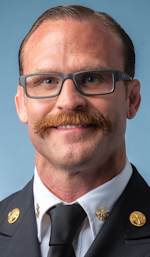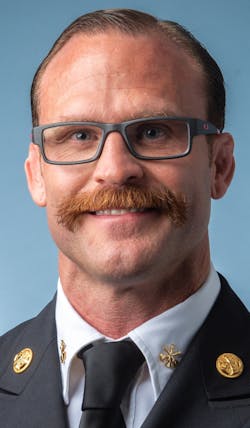Leadership Lessons: We’re All Followers Before Leaders
If you search for leadership books online, you will find hundreds of thousands of choices. If you search for followership books, you won’t find nearly as many. We are mesmerized and uncontrollably curious about what it takes to be a good leader. If we were just as interested in being a good follower, the progress of an organization and one’s own personal growth would be endless.
Defining followership
So, what exactly is followership? According to John McCallum, followership is a straightforward concept: “It is the ability to take direction well, to get in line behind a program, to be a part of a team, and to deliver on what is expected of you.”
Think about the rank structure we have in emergency services. It’s structured for a reason. However, sometimes we let that structure inhibit decision-making, progress and organizational success. Why? Because we all seem to be focused on being the person in the lead role and with all the answers. A good follower focuses on more than this. He or she focuses on the mission, vision and values of an organization. We can’t all be the fire chief, so we probably should stop acting like we are and understand our role in our organization.
When I say “understand our role,” I mean that many of us are followers who also lead other individuals. In my case, I’m a leader of an engine company and a follower of my battalion chief, my assistant chief, my deputy chief and my fire chief. As you can see, I’m much more of a follower than a leader. Therefore, I must understand my role in both leadership and followership. Is this difficult at times? Yes, very much so.
Simply put, without followers, you have no leaders. Followers carry the torch.
What makes a good follower?
Is it someone who lays down and agrees to everything? No. Is it a person who says yes to everything? No. It’s someone who’s not afraid to speak openly, honestly and realistically about the past, present and future of an organization to its leaders. This isn’t always easy, but it’s essential for the progress of an organization.
Being a good follower when you’re also a leader impacts the people around you. If you’re given an organizational directive and complain to your crew about how bad it is and how bad the organization’s leadership is, what does that do for the crew’s growth? What does it tell them about you? Well, this is what it does: Next time you give them a directive, they’re going to complain about you and your decision. Why? Because you did it to your leader so they feel they can do it to their leader—YOU.
This is a vicious cycle that cripples organizational growth and the progress of its members. Why do I know this? Because I used to be the guy not following and taking easy shots at the leaders any chance I could. You see, I didn’t understand the complexity of their leadership role nor had I ever experienced that much leadership responsibility. Thankfully, I learned the error of my ways from the exemplary people I work with every day. The organization I work for has great leaders and outstanding followers.
I’ve been working increasingly with private sector organizations to address the followership problem, and I’m continually confronted with the same issues. And these issues are not unique to emergency services. It’s in private industry, law firms, the medical field, educational environments and just about anywhere people are leading and following. It’s been going on for hundreds of years. It’s one of those problems that is always affecting organizations, no matter the type.
If we can remember that we’re all followers before we’re leaders, then that will reduce the problems exponentially. Why? Because then we can empathize with our leaders and understand the challenges they face on a larger scale.
For example, at the company officer level, I supervise three people, but think about my battalion chief. He has five times the number of people under him. How about my assistant chief? He has four times the number of people my battalion chief has under him. How about my deputy chief? Now he has all the assistant chief’s people and the battalion chief’s people, plus numerous administrative personnel. Now think about the big boss. He has everyone. Yes, span of control allows us to organize our structure much better. However, if one of those aforementioned leaders decides to not follow their respective leader, it’s a domino effect of failure, not because we’re bad people, but because we didn’t realize the importance of followership.
If you’re wondering about some of the characteristics of a good follower, here are a few to ponder the next time you’re in a difficult followership situation:
FOLLOWER:
F – Finds the positive in organizational decisions.
O – Observes the challenges that executive-level leaders face.
L – Listens intently to information given from the executive level and disseminates that information to their respective followers.
L – Leads their crew or battalion based on the organization’s mission, vision and values.
O – Organizes daily activities to ensure optimal work completion and development.
W – Welcomes new ideas from leaders and subordinates to increase organizational progress.
E – Exemplifies courage, strength and integrity.
R – Resists negativity, rumor mongering or undermining of leaders.
In sum
Remember, followership does not mean that you’re a “Yes person.” It means you understand an organizational directive and the impact you have on the success of that directive permeating through to your coworkers—and in a positive manner. Sometimes we all must reassess our reasons for not wanting to follow a new policy, procedure or memo and ask ourselves this: Are we hurting the mission, vision and values of an organization due to our lack of followership? I did this for about 4 years, and I assure you that all it did was cause problems. Thankfully, I know better now. I hope you can learn this as well.
Before you worry about becoming a good leader, focus on being a good follower. The rest will fall into place.
References
McCallum, J. S. “Followership: The Other Side of Leader

Dr. David Griffin
Dr. David Griffin is the assistant chief of administration in Charleston, SC. He was the operator of the first-due engine on June 18, 2007, when nine of his fellow firefighters perished. Griffin has come through the ranks in operations in every uniformed position, from firefighter to battalion chief and shift commander to his current position, during his 19-year career in Charleston. He has a bachelor's degree in education from The Citadel, a master's degree in executive fire service leadership, and a doctorate of education in organizational leadership and development. Griffin is the author of "In Honor of The Charleston 9: A Study of Change Following Tragedy," among three other books. He is an international speaker and instructor, a certified Chief Fire Officer and Chief Training Officer with The Center for Public Safety Excellence, an IFSAC/Pro Board-certified Fire Officer IV and a graduate of the Executive Fire Officer Program from the National Fire Academy. He is a graduate of Harvard University's Kennedy School of Executive Education program: Senior Executives in State and Local Government and of the Psychology of Leadership program at Cornell University's SC Johnson College of Business. Griffin is the owner of On A Mission, LLC, at drdavidgriffin.com.






